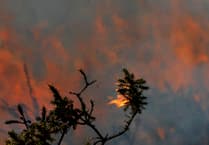A RARE breed of butterfly is thriving at Devon Wildlife Trust's Meeth Quarry nature reserve — and animal experts are carrying out a study to find out why.
The butterfly in question is the rare wood white. This beautiful butterfly has 'declined seriously' over the past century according to the organisation Butterfly Conservation and is now deemed to be a 'species of conservation concern'.
Yet at Meeth Quarry, the butterfly appears to be flourishing — so much so that the 150 hectare site and former ball clay quarry holds Devon's strongest colony and is thought to be the third largest stronghold for the species anywhere in England.
The Devon Wildlife Trust wants to understand just how well the butterfly is doing and how they can help it spread to other parts of the county.
To do this the charity is adopting an approach most often associated with monitoring birds.
This summer it is embarking on a mark, release and recapture programme (MRR) with a group of volunteers marking, releasing and recapturing as many of the reserve's wood whites as possible.
This means carefully capturing individuals, marking their wings with a harmless marker pen, recording their location and then returning later in the summer to attempt to recapture and record their movements.
Devon Wildlife Trust's Steve Hussey said: 'MRR will tell us not only how many wood whites there are, but also their movements and distribution.
'With this information we can better "fine tune" our management of the reserve's woodlands and grasslands to suit the butterflies.
'Our ambition is to see the beautiful and once common butterfly flying across the wider countryside of Devon.'
The small and dainty wood white butterfly likes warm, damp and sheltered spots, and can be seen along woodland rides and edges, sometimes in meadows.
Much of the butterfly's preferred habitats have been lost over the last 100 years.
You can see wood whites flying from the end of May until the end of July.
At Meeth, females have been spotted laying eggs on the plant bird's foot trefoil in sunny areas.
When they appear, the butterfly's larvae are camouflaged green and feed on the fresh growth of the plant and other members of the pea family. The larvae pupate over winter in amongst grasses before emerging the next year as adult butterflies.
To find out more about the work of Devon Wildlife Trust visit http://www.devonwildlifetrust.org">www.devonwildlifetrust.org




Comments
This article has no comments yet. Be the first to leave a comment.